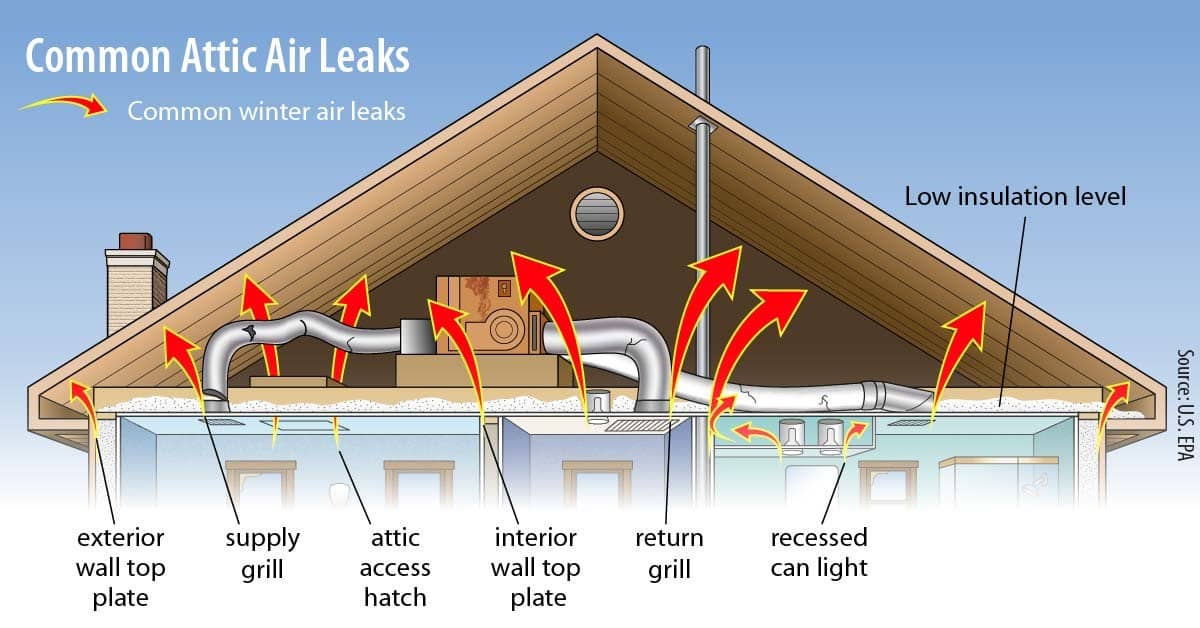Attic air sealing is a process that helps to reduce energy costs by preventing air from leaking out of your home. Year after year, we regret not having taken into account these valuable cost-reducing tips prior to the summer heat, as we are faced with soaring energy bills once the heat dissipates. Thinking ahead helps, with a free attic inspection, Attic Health team can come out and let you know how much waste in your HVAC system is due to attic insulation and air sealing. Air Sealing and insulation can help to keep your home more comfortable by stopping hot drafts and helping regulate the summer temperatures. Air sealing and insulation are an important part of making sure that your home is as energy efficient as possible in the summer heat.
What is Attic Air Sealing?
Attic Health can greatly be impacted by air leaks, old insulation, and damages such as water leaks. Simply put, air sealing is a crucial process in improving HVAC efficiency and maintaining a cooler home during the scorching summer months. Attic cleaning and insulation play a significant role in creating a comfortable living environment, but they can be rendered less effective by attic air leaks. This is where attic air sealing comes into play. Attic air sealing involves identifying and sealing any gaps, cracks, or holes in the attic space that allow conditioned air to escape or unconditioned air to infiltrate the living areas. By addressing these leaks, the energy efficiency of the HVAC system is greatly enhanced, as it no longer needs to compensate for the loss or gain of air. This, in turn, translates into reduced energy consumption and lower utility bills in summer heat.
Attic Insulation Efficiency
Attic insulation installation and old attic insulation removal are also crucial steps that go hand in hand with air sealing, as they ensure optimal thermal resistance and prevent the transfer of heat into the living space. With a well-sealed attic, homeowners can enjoy a more comfortable and cooler indoor environment during the summer while reaping the benefits of improved energy efficiency. Proper attic insulation installation helps maintain consistent temperatures and reduces the workload on the HVAC system, leading to long-term energy savings. Additionally, removing old attic insulation is necessary if it is damaged, mold-infested, or no longer effective. In such cases, professional attic insulation removal ensures a thorough and safe process, allowing for the installation of fresh, efficient insulation. By combining air sealing, insulation installation, and old insulation removal, homeowners can create an attic environment that supports better HVAC performance, energy efficiency, and overall comfort.
Benefits of Attic Air Sealing
- Can reduce your energy bills by up to 20%.*
- Minimizes drafts and discomfort in all rooms of your home.
- Helps reduce potential health risks from pollutants.
- Reduce pest access and moisture access.
- According to Energy Smart, uninsulated walls can account for 20 to 40 percent of your home’s air leakage.
- Also, according to Energy Star, the EPA estimates savings of 15% on heating and cooling costs by properly air sealing your attic and adding insulation.
How to Air Seal Your Attic
Let’s get to air sealing your attic properly! One effective way to air seal your home is by identifying air leaks and then caulking and sealing gaps. You can start by inspecting your home’s exterior and interior, checking for any gaps, cracks, and holes. Once you have identified these areas, you can seal them using weather stripping, caulk, and foam sealant. Additionally, you can add insulation to your attic and walls to further improve energy efficiency and reduce air leaks. If you require additional support with air sealing your home, feel free to contact The Attic Health team today. Our experts can provide you with a free attic inspection, guiding you towards a clean and efficiently sealed attic just in time for summer. Cleaning your attic is also important, consider reading this article on the Importance of Attic Cleaning.

This image was provided by the EPA to help homeowners learn about the financial, as well as comfort and environmental, benefits of sealing and insulating their attics and encourage homeowners to take action to improve the insulation in their own attics.
Identifying Attic Air Leaks
Start by examining the attic space during daylight hours. Look for any signs of sunlight coming through cracks or gaps in the roof. Pay close attention to areas where the roof meets the walls, chimneys, vents, and skylights. Additionally, inspect the attic insulation for signs of moisture, such as dampness, discoloration, or mold growth, as these indicate potential leaks. If you discover mold on the old insulation, it is crucial to consider involving experts, as mold can pose health risks. Consider removing the old insulation if it is heavily damaged, mold-infested, or no longer effective. In such cases, professional attic insulation removal is recommended to ensure a thorough and safe removal process. By identifying and addressing leaks in the roof or attic promptly, you can prevent further damage, improve energy efficiency, and maintain a healthy living environment. For more on attic insulation, please read more of our Attic Insulation Basics article.
Caulking and Sealing Gaps
Caulking and sealing gaps in your attic is a crucial step in maintaining a healthy and energy-efficient living space for the summer weather. Attic air leaks can lead to energy loss and potential moisture problems, making it essential to address them promptly. Before applying caulking, it’s important to prioritize attic health by thoroughly cleaning the area. Remove any dust, debris, or old caulking to ensure a clean surface for proper adhesion. Once the area is cleaned, you can proceed with sealing the gaps using high-quality caulking materials. By effectively sealing attic air leaks, you create a barrier that prevents conditioned air from escaping and unconditioned air from infiltrating the living areas. This not only improves HVAC attic efficiency but also helps maintain a comfortable and consistent indoor temperature throughout your home.
Installing Weather Stripping
First, identify the areas in your attic where air leaks commonly occur, such as around windows, doors, vents, and access hatches. No worse issue than losing your cold air conditioned out the window because it isn’t sealed properly. To replace the seal, thoroughly clean and remove any debris or old weather stripping from these areas. Next, measure the dimensions of the openings to ensure accurate weather strip sizing. Choose high-quality weather stripping materials suitable for your specific needs, such as adhesive-backed foam or V-strip weather stripping. Cut the weather stripping to the appropriate lengths and carefully attach it to the designated areas, making sure it creates a tight seal when closed. Pay extra attention to corners and joints, as they can be prone to air leaks. Finally, test the effectiveness of the weather stripping by closing doors, windows, and access points to ensure a snug fit and eliminate any remaining gaps. This thorough weather stripping process will help seal air leaks in your attic, enhancing energy efficiency and maintaining a comfortable indoor environment. Radiant barriers may also be an area you might want to consult an expert, if you like read more about radiant barriers here!
Attic Health Wrap-Up
Air sealing is a crucial step in improving energy efficiency and creating a comfortable living environment prior to summer heat. By addressing attic air leaks, old insulation, and sealing gaps, homeowners can significantly reduce energy bills and minimize drafts and discomfort in their homes. It is important to prioritize attic health by thoroughly inspecting for air leaks and potential mold growth. In cases where mold is discovered on the old insulation, involving experts for proper removal and new insulation installation is crucial to maintain a healthy living space. Additionally, caulking and sealing gaps, as well as installing weather stripping, further enhance the effectiveness of air sealing. Regular inspection and maintenance of air sealing materials are recommended to ensure long-term efficiency. By implementing these measures, homeowners can enjoy the benefits of improved energy efficiency, reduced utility bills, and a more comfortable home.
- Air sealing can help reduce summer energy bills and provide a more comfortable living environment.
- Be sure to call an expert in case of mold discovery
- Proper identification of air leaks and installation of the right materials is essential for a successful air sealing project.
- Regular inspection and maintenance of air sealing materials is recommended to ensure effectiveness over time. (recommended prior to every summer or winter)
- Professionals may be needed for insulation removal or installation. Call us today if you would like a free estimate on insulation removal or installation.

